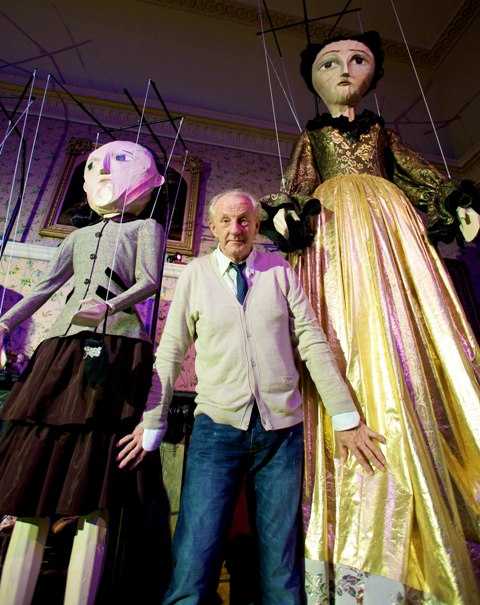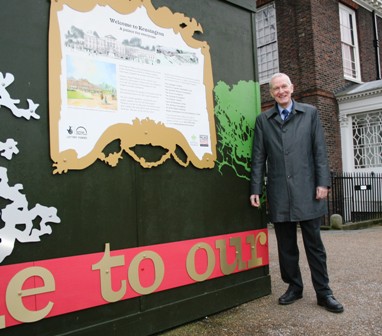
Fashion designer Paul Costelloe with his new installation for
the Enchanted Palace,
An enchanted palace: new plans and a different approach to funding
According to Rod Giddins, the current development project at Kensington Palace illustrates the benefits of a charity such as Historic Royal Palaces operating free from government funding. After a personal tour of the current Enchanted Palace exhibition, he told The Leisure Review why.

Fashion designer Paul Costelloe with his new installation for
the Enchanted Palace,
By March 2012 Kensington Palace will be a palace transformed. A £12 million project is currently underway to create a royal palace that is fully accessible in every sense of the phrase, bringing a rejuvenated visitor experience that will include extensive new visitor facilities, a new ticketing system and a new interpretation of the building and the collections it displays, as well as a new garden. With work taking place to remodel numerous parts of the palace and its grounds, the Kensington Palace team had to create a new exhibition to fit both the spirit of the palace’s renewal and any restrictions on visitor access that building work might require. The resulting display, titled The Enchanted Palace, has played a significant part in preparing the staff and the palace’s visitors for the changes to come, all while ensuring that visitors hoping for a traditional palace tour still have a rewarding experience.
In his post as palaces group director Rod Giddins has responsibility for almost every aspect of the management, maintenance and visitor experience at Kensington Palace, Hampton Court Palace and Kew Palace. Visitor services, front-of-house operations, grounds and estates, events and functions, commercial development, income generation, partnerships, security, and facilities management are included within his remit and all these aspects of his role have played a part in the development of the Kensington Palace project.
“The title of the major project,” Rod explained, “is ‘Kensington Palace: a palace for everyone’. The idea is that we will not only open the palace to more visitors but we will make it physically accessible – we’ve not previously had a lift to the main state apartments, for example – and we make it intellectually more accessible. The palace has lots of stories that haven’t always been told in the most engaging way so the idea is that we tell stories that attract new audiences as well as our more traditional visitors. Around 70% of our visitors are from overseas so we’d like to get more Londoners involved in what we’re doing and support our charitable cause. We have a big stakeholder communication plan and we’ve engaged a lot more with local communities. Our outreach and communities team has been going out to talk to lots of different local groups, many of which are coming to the palace for the first time.
“But our challenge, as with other projects, is that we had to keep the palace open because we need the income from visitors, along with the retail and the functions business, but we couldn’t keep all of it open. What to do? We wondered whether we could do something entirely different within the palace, something to attract new audiences while retaining that sense of a special place, because it is after all a royal palace. We came up with the idea of an enchanted palace, a palace being transformed; something magical and very different. The next part of the challenge was to make this an immersive experience for visitors.”
Both Kensington Palace and the Borough of Kensington have long been associated with couture, the palace as the home to the royal ceremonial dress collections and Kensington as the home to some of the most celebrated fashion houses. Staff contacts with local fashion designers prompted the concept of fashion-related installations within the state apartments as part of the storytelling process. A theatre company, Wildworks, was also engaged to help the curatorial and front-of-house staff with the task of bringing these stories to life. It has proved a great success.
“The staff role had tended to be that of warders, standing in rooms with visitors using an audio guide moving around them,” Rod said. “Dialogue was limited and we thought that they need to become the voice, the storytellers for the palace. We’ve done a lot of work with our staff over the last five years across all the palaces in terms of them becoming storytellers so this was a real opportunity to test the extent to which they could engage with visitors while still carrying out their roles regarding security, health and safety, protection of the artefacts, et cetera. The theatre company was important in giving staff confidence to tell stories, engage with visitors and use third-person storytelling techniques. They opened up lot of innate abilities among members of staff, all of whom have risen to the challenge and been brilliant. In a year they have been transformed from warders to brilliant storytellers, engaging visitors in a way that I don’t think I could have dreamed would be possible a few years ago.”
As an organisation Historic Royal Palaces (HRP) has recognised that the scale of the task they were undertaking at Kensington Palace is rather extraordinary. It is a major redevelopment project of an historic palace, during which the building will remain open, the role of staff and what is expected of them will be transformed, and a major new installation, involving collaboration with external designers and performers, will be created. Such activity, HRP concluded, is about as far as the boundary could possibly have been pushed and evaluation of the process has been personally led by the HRP chief executive, Michael Day, to ensure that the lessons of such an approach to change management can be captured.
Rod conceded that the process has not been easy but that hard work has paid off. “A lot of people were involved but once staff were confident that they were going to be a part of this future for the palace, they saw that there was real benefit for them personally and responded positively. I’ve seen staff here just grow in stature, in confidence. It’s been fantastic to see. If we had just kept the palace open and delivered the traditional visitor experience I’m sure we wouldn’t have been ready for a new palace in 2012. And given that we’re spending £12 million we need to make sure that the interpretation, the presentation, the stories, the welcome – all those things we have to do to encourage more people to come and visit us – have been done.”
The Enchanted Palace “installation” – Rod insists that it is not an exhibition – encourages visitors to explore the stories of the seven princesses associated most closely with the palace, bringing art and couture installations, along with strikingly dramatic lighting, to what were once impressive but comparatively staid state apartments. Preview days ahead of the opening last March delivered feedback and suggestions for improvements, most notably improved lighting away from the installations and more written interpretation material, but also the prospect of a new audience drawn to the themes of art and fashion rather than the royal associations. The installations have been regularly changed since March 2010 and a new set of works will be displayed from May 2011 until December, when the palace will close to the public for a couple of months in preparation for the opening of the transformed palace in March 2012.
Rod is adamant that this transformation and the investment required to achieve it serve to illustrate the success of HRP as an independent charity. The organisation, which was established in 1998 to look after the five palaces owned by the monarch on behalf of the nation, had been part of the government departmental structure until 1989 when it was established as a government agency. HRP continued to receive public funding but, having been adept at generating income and increasing its conservation and educational work, it became an independent charity in 1998. In 1999 public funding was ended and HRP has operated under contract to DCMS but independent of government funding ever since, generating sufficient income to open the palaces, conserve and repair them, expand education and outreach work and develop new facilities for visitors. The majority of revenue is generated by visitor fees, with significant contributions from retail and events, and HRP turnover this year will be in the region of £60 million. A fundraising team works to generate support for major developments, which for the Kensington project means that they are tasked with raising £6 million, more than £4 million of which has been raised in just two years.
“Of course, one always has to be careful about what one includes on the cost side of the equation,” said Rod, “but at an operational level Kensington Palace makes a surplus. All the palaces have to work as one within the organisation and the Tower of London makes more money than the other palaces so our job is to maximise the income at each palace, keep the costs down, and have enough money set aside for outreach work, education work and conservation projects. The task is to put the palaces into a better condition than they were when we became a charity in 1998 so that in 50 years time someone can look back and say, that charity that ran the palaces for all those years – and we don’t know how long we’ll have a contract with government to run them – did an excellent job.
“We have a ten-year plan of investment for all our palaces going through to 2020. The financial model is that we depend upon visitor income for 60% of our revenue but enterprises through retail, function, events and catering are all key elements, as they are at any museum that runs as a business these days. It is also about looking at the cost base constantly, asking whether we can get more for the same amount of money or whether there is any waste. As a charity, our mindset has changed from that of being part of a government department that gets funding through an annual cycle of grant-in-aid. Even a three-year rolling programme can be a constraint if you want to do a re-presentation of a historic building. We are able to take a long-term view and say that, provided we maintain our visitor numbers and other income sources, we can have a long-term investment plan. I think being independent of public subsidy frees you to think in a very different way.”
At the end of March 2012 visitors will be able to judge the transformation of Kensington Palace for themselves. Meanwhile, HRP staff will be planning for 2016, without the assistance of the treasury.
The Leisure Review, February 2011
© Copyright of all material on this site is retained by The Leisure Review or the individual contributors where stated. Contact The Leisure Review for details.
Download a pdf version of this article for printing
